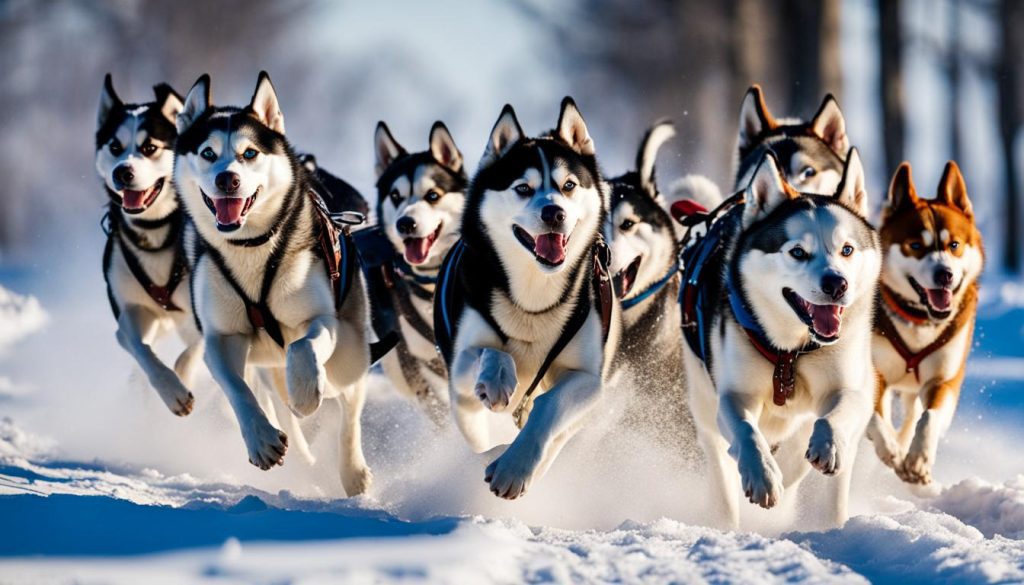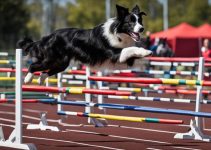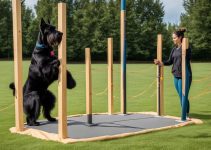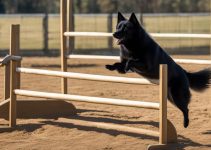Siberian Huskies are unique and captivating dogs known for their friendly nature and mischievous personalities. If you’re lucky enough to have one as a furry companion, proper training is crucial to ensure a well-behaved and happy pup. In this guide, I will share effective Siberian Husky training methods and techniques for obedience, socialization, and husbandry.
Siberian Husky Training
- Start training your Siberian Husky at a young age to establish good behaviors from the beginning.
- Invest in essential training equipment such as a leash, treats, collar, harness, grooming brush, and crate.
- Understand the active and energetic nature of Siberian Huskies and provide them with plenty of exercise and mental stimulation.
- Teach essential commands like sit, lie down, recall, and leash walking to ensure obedience.
- Socialize your Husky puppy early on to prevent fear-based behaviors and aggression.
By following these tips and techniques, you can train your Siberian Husky to be a well-behaved and happy companion. Remember, patience, consistency, and positive reinforcement are key in training your beloved Husky. Let’s dive into the wonderful world of Siberian Husky training together!
Essential Training Equipment for Siberian Husky Puppies
When it comes to Siberian Husky training especially the puppy ones, having the right equipment is key to success. Here are some essential items that every Siberian Husky owner should consider:
1. Long Leash
A long leash is vital for giving your Husky puppy some freedom while still maintaining control during training sessions. It allows them to explore and sniff around while you work on commands and leash walking.
2. Treat Pouch and High-Value Treats
A treat pouch keeps your hands free and ensures easy access to rewards. Choose high-value treats that your Husky puppy finds irresistible as a powerful motivator for positive reinforcement training.
3. Soft Collar and Harness
A soft collar and harness are essential for walks and outdoor activities. They provide a comfortable fit and ensure your puppy’s safety and security.
4. 2-Meter Training Leash
A 2-meter training leash is the preferred length for leash walking training. It allows your Husky puppy to explore their surroundings while you establish good leash manners.
5. Non-Slip Vet Bed or Soft Mat
Teaching your puppy a “place” cue is essential for creating a safe and calm space. A non-slip vet bed or soft mat can be used to define their designated area and prevent nuisance behaviors.
6. Identical Toys
Identical toys are perfect for playing fetch and teaching your Husky puppy to retrieve. Make sure to use toys that are safe and durable.
7. Soft Slicker Grooming Brush and Comb
Regular grooming is necessary to maintain your Husky’s thick coat. A soft slicker grooming brush and comb help keep their fur free from tangles and matting.
8. Crate and Playpen
A crate and playpen provide a secure space for your Husky puppy when needed. A crate can aid in house training and safe confinement, while a playpen allows for supervised playtime.
Having these essential Siberian Husky training equipment items will set you and your Siberian Husky puppy up for success. With the right tools, you can create a positive and effective training environment.
The Active and Energetic Nature of Siberian Huskies
Siberian Huskies are a remarkable sledge-pulling breed with a long history of service to nomadic tribes in northern Asia. Renowned for their athleticism and stamina, Huskies are an active breed that requires a significant amount of physical and mental exercise to thrive. These high-energy dogs are not suited for a couch potato lifestyle, and understanding their exercise needs is essential for their overall well-being.
When it comes to exercise, Siberian Huskies are in a league of their own. Whether it’s a long hike, a challenging jog, or a fun game of fetch, these dogs need regular opportunities to burn off their energy. A tired Husky is a happy Husky, and meeting their exercise requirements is key to preventing behavior issues that can arise from pent-up energy.
Along with physical exercise, mental stimulation is also crucial for Huskies. These intelligent dogs thrive on engaging tasks and problem-solving activities. Puzzle toys, obedience training, and interactive games can help keep their minds sharp and prevent boredom.
The Benefits of Exercise for Siberian Huskies
- Physical fitness: Regular exercise helps keep Huskies fit and at a healthy weight, reducing the risk of obesity-related health issues.
- Mental well-being: Engaging in activities that challenge their minds can prevent boredom and destructive behaviors.
- Behavior management: Adequate exercise helps prevent behavioral problems such as excessive barking, digging, and chewing.
- Bonding opportunity: Enjoying outdoor activities together strengthens the bond between you and your Husky.

Providing regular exercise for your Siberian Husky should be a priority. Aim for at least 30 to 60 minutes of intense physical activity each day. This can include walks, runs, hikes, or activities such as agility training or obedience trials. It’s important to note that every dog is unique, and their exercise needs may vary based on age, health, and individual traits. Consulting with a veterinarian or a professional dog trainer can help you determine an appropriate exercise routine for your Husky.
Remember, a tired and well-exercised Siberian Husky is more likely to be a happy and well-behaved companion. So lace up your shoes, grab your Husky’s leash, and embark on exciting adventures together!
Essential Commands for a Well-Behaved Husky Puppy
Teaching basic obedience commands to your Husky puppy is crucial for their proper behavior and overall well-being. These commands lay the foundation for a well-behaved and happy pup, ensuring a harmonious relationship between you and your furry friend.
Sit and Lie Down
One of the first commands your Husky puppy should learn is to sit and lie down on command. This not only helps with their impulse control but also establishes you as the leader and teaches them to focus and pay attention. Use positive reinforcement, such as treats and praise, to encourage your puppy to sit and lie down.
Learn their Name
Teaching your Husky puppy their name is essential for effective communication. Start by saying their name every time you interact with them and rewarding them with treats or praise when they respond. This helps them associate their name with positive experiences and reinforces their bond with you.
Come when Called
Recall training is especially important for Huskies, as they may have a strong inclination to wander. Teach your puppy to come when called by using positive reinforcement and practicing in a controlled environment. Gradually increase the distractions while ensuring you always reward their responsiveness.
Walk Nicely on a Leash
Walking nicely on a leash is crucial for both your Husky’s safety and your enjoyment during walks. Start by introducing them to a leash and collar or harness and reward them for walking close to you without pulling. Consistency and patience are key when teaching leash manners.
Play Fetch
Huskies have a natural prey drive and love to chase. Teaching your puppy to play fetch not only provides mental and physical stimulation but also helps to reinforce basic obedience commands. Use their favorite toys or balls to initiate the game, and reward them when they bring it back to you.
Sleep in their Crate
Creating a positive association with their crate is essential for your Husky puppy’s well-being and proper house training. Introduce the crate as a cozy and safe space and gradually increase the time they spend inside. Use treats and comforting words to reinforce positive experiences inside the crate.
Cope with Being Left Alone
Helping your Husky puppy cope with being left alone is crucial to prevent separation-related anxiety and destructive behaviors. Start by leaving them alone for short periods, gradually increasing the duration. Provide engaging toys, comforting scents, and a safe environment to help them feel secure in your absence.
Go to the Bathroom in the Right Place
Potty training your Husky puppy is one of the most important aspects of their training. Establish a routine and take them to their designated bathroom spot regularly. Reward them with treats and praise when they go in the right place. Consistency and positive reinforcement are key to successful potty training.
By patiently and consistently teaching these essential commands, you will have a well-behaved and happy Husky puppy. Remember to always use positive reinforcement and tailor the training to your puppy’s individual needs and personality.
The Importance of Socializing Your Siberian Husky
Socialization exercises play a crucial role in the development of a well-adjusted Siberian Husky puppy. Introducing your puppy to a variety of people and other dogs at a young age helps prevent fear-based behaviors and aggression later in life. Puppy socialization and training classes can be valuable for teaching proper interaction with others.
When socializing your Siberian Husky, it’s important to create positive experiences in various environments. Allow your puppy to meet friendly dogs of different sizes and breeds to learn appropriate social cues. Encourage positive interactions and reward good behavior with treats and praise.
- Show your puppy how to interact politely with other dogs. Teach them to approach calmly, sniff, and engage in play if both dogs are comfortable.
- Introduce your puppy to a wide range of people, including men, women, children, and people wearing different types of clothing or accessories. This will help your Husky become comfortable and confident in various social situations.
- Expose your puppy to different environments such as parks, sidewalks, busy streets, and shopping areas. Gradually increase the level of stimulation to help your puppy adapt to new sights, sounds, and smells.
- During fear periods, which are normal stages of development, provide a supportive and positive environment. Comfort your puppy and expose them to gentle, positive experiences to build resilience and confidence.
Remember that socialization is an ongoing process throughout your Husky’s life. Regularly exposing them to new experiences and reinforcing positive interactions with both people and dogs will help maintain their social skills and prevent behavior problems.
Essential Maintenance Tasks for a Healthy Husky Puppy
Proper husbandry is essential for keeping a Husky puppy healthy. Let’s explore some essential maintenance tasks that will contribute to your pup’s well-being.
Grooming and Brushing
Grooming plays a crucial role in maintaining your Husky’s thick coat and reducing shedding. Regular brushing not only helps remove loose hair but also prevents matting and keeps their fur looking clean and healthy. Using a soft slicker grooming brush, gently brush your Husky’s coat, paying extra attention to areas that tend to get tangled, such as behind the ears and in the undercoat.
Hygiene and Ear Care
Keeping your Husky’s ears clean is important to prevent infections. Use a damp cloth or ear cleaning solution recommended by your veterinarian to gently wipe the outer part of their ears. Avoid inserting anything inside the ear canal. If you notice any signs of redness, discharge, or discomfort, consult your vet for further evaluation.
Eye Health
Regular eye checks are essential for identifying any potential eye issues in Huskies. Keep an eye out for signs of redness, discharge, cloudiness, or squinting. If you notice any abnormalities, consult your vet promptly. Some common eye conditions in Huskies include cataracts and corneal dystrophy.
Foot Care
Taking care of your Husky’s feet is crucial for their mobility and overall well-being. Trim long hairs around the paws to prevent matting and keep the feet clean. Additionally, check their nails regularly and trim them as needed, being cautious not to cut too close to the quick. Healthy feet will ensure their comfort while walking and running.
By incorporating these essential maintenance tasks into your routine, you can help keep your Husky puppy healthy and happy. Remember to consult your veterinarian for any specific grooming or health-related concerns.
Preventing Escapes and Managing Husky Behavior
Huskies, known for their escapability and energetic nature, require proper management to ensure their safety and well-being. Implementing effective escape prevention measures and setting clear boundaries are essential for managing their behavior. Additionally, providing adequate exercise, socialization, and training is crucial for a well-rounded and well-behaved Husky.
Escape Prevention
To prevent Huskies from escaping, secure fencing is necessary. Huskies are known for their digging abilities and agility, so it’s important to choose a fence that is tall, sturdy, and buried deep enough to prevent digging under. Regularly check the fence for any potential weak points or escape routes. Ensuring a safe and secure environment is key to keeping your Husky from wandering off.
Exercise and Socialization
Huskies are an active breed with high energy levels, making regular exercise a necessity. In Siberian Husky training, you should provide daily opportunities for physical and mental stimulation through activities such as walks, runs, and interactive play. Engaging in exercise and play not only helps burn off energy but also provides an outlet for their natural instincts. Socialization is equally important—exposing your Husky to various people, animals, and environments from a young age helps prevent fear-based behaviors and promotes positive interactions.
Setting Boundaries
Establishing clear boundaries is essential for managing Husky behavior. Consistency is key in enforcing rules and expectations. Use positive reinforcement techniques to reward good behavior and redirect unwanted behaviors. Establishing a routine and providing structure can help your Husky understand what is expected of them and prevent them from engaging in destructive or undesirable behaviors.
Potty Training, Crate Training, and Leash Training
Proper potty training is crucial for a well-behaved Husky. Use positive reinforcement and consistency to teach your puppy where to go to the bathroom. Crate training can also be beneficial, providing a safe and comfortable space for your Husky when no one is home or during sleep time. Leash training is important for teaching your Husky to walk nicely on a leash and preventing them from pulling. Consistent training and positive reinforcement will help instill good behaviors.

Clicker Training
Clicker training is a highly effective technique for teaching commands and obedience. By using a clicker to mark desired behavior and following it with a reward, you can communicate clearly with your Husky and reinforce positive behaviors. Clicker training helps establish a strong bond between you and your Husky, making the training process enjoyable and rewarding for both of you.
By implementing escape prevention measures, providing ample exercise and socialization, setting clear boundaries, and incorporating positive training techniques, you can effectively manage your Husky’s behavior and ensure a happy and well-behaved companion.
Training a Happy and Well-Behaved Siberian Husky
Siberian Husky training can be a rewarding journey filled with love, joy, and companionship. To ensure success, it’s important to approach training with patience, consistency, and an understanding of their unique breed traits. By using positive reinforcement as the foundation of your training techniques, you can create a happy and well-behaved Husky that will bring you endless happiness.
Positive reinforcement involves rewarding your Husky with treats, praise, and affection whenever they exhibit the desired behavior. This encourages them to repeat the behavior and strengthens the bond between you. Remember to set clear boundaries and be consistent with your expectations, as this will help your Husky understand what is expected of them.
In addition to Siberian Husky training, ensuring your Husky gets proper exercise and socialization is crucial for their overall well-being. Huskies are an active breed and thrive in environments that allow them to release their energy. Regular exercise, such as daily walks or playtime in a secure yard, will keep them physically and mentally stimulated. Socialization with other dogs and people from a young age will help them develop into well-rounded and friendly companions.
Each Husky is unique, so it’s important to tailor your training methods to their individual needs. If you’re unsure of how to proceed or encounter difficulties along the way, don’t hesitate to seek professional help. With time, patience, and the right approach, you can train a happy and well-behaved Siberian Husky that will bring you years of love and joy.
FAQ
What equipment do I need to train a Siberian Husky puppy?
To train a Siberian Husky puppy, you will need a long leash, treat pouch, high-value treats, soft collar, harness, 2-meter training leash, non-slip vet bed, identical toys, soft slicker grooming brush, comb, crate, and playpen.
How active are Siberian Huskies?
Siberian Huskies are a sledge-pulling breed with high energy levels. They require a significant amount of physical and mental exercise and are not suited for a sedentary lifestyle.
What are some essential commands to teach a Husky puppy?
Some essential commands to teach a Husky puppy include sit, lie down, learn their name, come when called, walk nicely on a leash, play fetch, sleep in their crate, cope with being left alone, and go to the bathroom in the right place.
Why is socializing a Siberian Husky important?
Socializing a Siberian Husky is crucial to prevent fear-based behaviors and aggression. It involves introducing the puppy to different people and other dogs, teaching proper interaction and behavior.
What maintenance tasks are important for a healthy Husky puppy?
Important maintenance tasks for a healthy Husky puppy include brushing their thick coat regularly, grooming sensitive areas, checking their eyes for common conditions, and taking care of their feet by trimming long hairs and nails.
How can I prevent escapes and manage Husky behavior?
Preventing escapes and managing Husky behavior involves using secure fencing, providing adequate exercise and mental stimulation, setting clear boundaries, potty training, crate training, leash training, and using clicker training for effective commands and obedience.
How can I train a happy and well-behaved Siberian Husky?
Training a happy and well-behaved Siberian Husky involves using positive reinforcement, understanding their unique breed traits, and tailoring training techniques to their individual needs. Seek professional help if needed.






